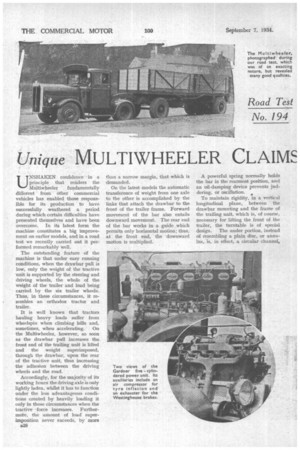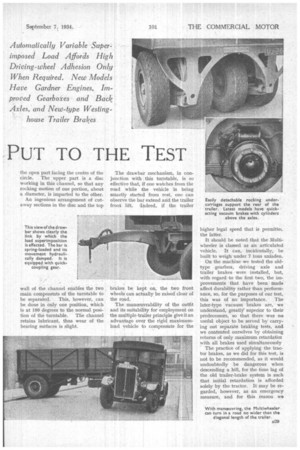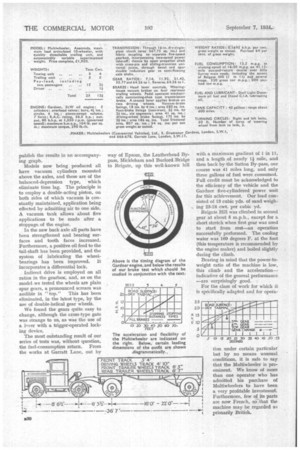Unique MULTIWHEELER CLAIMS
Page 42

Page 43

Page 44

If you've noticed an error in this article please click here to report it so we can fix it.
PUT TO THE TEST
UNSHAKEN confidence in a principle that renders the Multiwheeler fundamentally different from other commercial vehicles has enabled those responsible for its production to have successfully weathered a period during which certain difficulties have presented themselves and have been overcome. In its latest form the machine constitutes a big improvement on earlier models, and in a road test we recently carried out it performed remarkably well.
The outstanding feature of the machine is that under easy running conditions, when the drawbar pull is low, only the weight of the tractive unit is supported by the steering and driving wheels, the whole of the weight of the trailer and load being carried by the six trailer wheels. Thus, in these circumstances, it resembles an orthodox tractor and trailer.
It is well known that tractors hauling heavy loads suffer from Nirheelspin when climbing hills and, sometimes, when accelerating. On the Multiwheeler, however, so soon as the drawbar pull increases the front end of the trailing unit is lifted and the weight superimposed, through the drawbar, upon the rear of the tractiveunit, thus increasing the adhesion between the driving wheels and the road.
Accordingly, for the majority of its working hours the driving axle is only lightly laden, whilst it has to function under the less advantageous conditions created by heavily loading it . only in those circumstances when the tractive force increases. Furthermote, the amount of load superimposition never exceeds, by more 1128 than a narrow margin, that which is demanded.
On the latest models the automatic transference of weight from one axle to the other is accomplished by the links that attach the drawbar to the front of the trailer frame. Forward movement of the bar also entails downward movement. The rear end of the bar works in a guide which permits only horizontal motion; thus, at the front end, the downward motion is multiplied. A powerful spring normally holds the bar in the rearmost position, and an oil-damping device prevents juddering, or oscillation.
To maintain rigidity, in a vertical longitudinal plane, between the drawbar mounting and the frame of the trailing unit, which is, of course, necessary for lifting the front of the trailer, the turntable is of special design. The under portion, instead of resembling a plain disc, or annulus, is, in effect, a circular channel, the open part facing the centre of the circle. The upper part is a disc working in this channel, so that any rocking motion of one portion, about -a diameter, is imparted to the other.
An ingenious arrangement of cutaway sections in the disc and the top wall of the channel enables the two main components of the turntable to
be separated. This, however, can be done in only one position, which is at 180 degrees to the normal position of the turntable. The channel retains lubricant, thus wear of the bearing surfaces is slight.
The drawbar mechanism, in conjunction with this turntable, is so effective that, if one watches from the road while the vehicle is being smartly started from rest, one can observe the bar extend and the trailer front lift. 'Indeed, if the trailer brakes be kept on, the two front wheels can actually be raised clear of the road.
The rnanceuvrability of the outfit and its suitability for employment on the multiple-trailer principle give it an advantage over the rigid maximumload vehicle to compensate for the
higher legal speed that is permittec the latter.
It should be noted that the Multiwheeler is classed as an articulated vehicle. It can, incidentally, be built to weigh under 7 tons unladen.
On the machine we tested the oldtype gearbox, driving axle and trailer brakes were installed, but, with regard to the first two, the nil-, provements that have been made affect durability rather than performance, so, for the purposes of our test, this was of no importance. The later-type vacuum brakes are, we understand, greatly superior to their predecessors, so that there was no useful object to be served by carrying out separate braking tests, and we contented ourselves by obtaining returns of only maximum retardatior with all brakes used simultaneously
The practice of applying the trac. tor brakes, as we did for this test, is not to be recommended, as it would undoubtedly be dangerous when descending a hill, for the time lag of the old trailer-brake system is such that initial retardation is afforded solely by the tractor. It may be regarded, however, as an emergency measure, and for this reason we publish the results in an accompanying graph.
Models now being produced all have vacuum cylinders mounted above the axles, and these are of the balanced-depression type, which eliminate time lag. The principle is to employ a double-acting piston, on both sides of which vacuum is constantly maintained, application being effected by admitting air to one side. A vacuum tank allows about five applications to be made after a. stoppage of the engine.
In the new back axle all parts have been strengthened and bearing surfaces and tooth faces increased. Furthermore, a positive oil feed to the tail-shaft has been provided, and the system of lubricating the wheelbearings has been improved. It incorporates a differential lock.
Indirect drive is employed on all ratios in the gearbox, and, as on the model we tested the wheels are plain spur gears, a pronounced scream was audible in top." This has been eliminated, in the latest type, by the use of double-helical gear wheels.
We found the gears quite easy to change, although the cross-type gate was strange to us, as was the use of a hwer with a trigger-operated locking device.
The most outstanding result of our series of tests was, without question, the fuel-consumption return. From the works at Garratt Lane, out by
way of Epsom, the Leatherhead Bypass, Mickleham and Burford Bridge to Reigate, up this well-known hill with a maximum gradient of 1 in 11, and a length of nearly l mile, and then back by the Sutton By-pass, our course was 41 miles long, and only three gallons of fuel were consumed. Full credit must be acknowledged to the efficiency of the vehicle and the Gardner five-cylindered power unit for this achievement. Our load consisted of 13 cubic yds. of sand weighing 23-24 Cwt. per cubic yd.
Reigate Hill was climbed in second gear at about 5 m.p.h., except for a short stretch when first gear was used to stark from rest—an operation successfully performed. The cooling water was 160 degrees F. at the foot (this temperature is recommended by the engine maker) and boiled slightly during the climb.
Bearing in mind that the power-toweight ratio of the machine is low, this climb and the acceleration—. indicative of the general performance —are surprisingly good. I For the class of work for which it is specifically adapted and for opera
tion under certain particular but by no means unusual conditions, it is safe to say that the MuItiwheeler is preeminent. We know of more than one operator who has admitted his purchase of Multiwheelers to have been a very profitable investment. Furthermore, few of its parts are now French, so4that the machine may be regarded as primarily British.




























































































